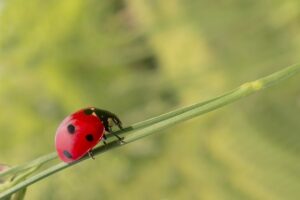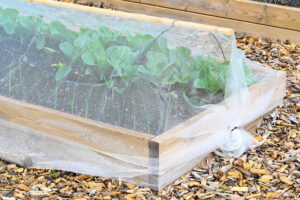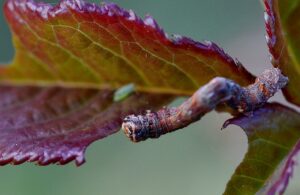Introduction
Organic pest management is a great way to keep your garden, landscape and home free of pests without relying on harsh chemicals. This is especially important for the food you eat. It involves utilizing various natural methods to eliminate or control the presence of insects and other pests from damaging plants and structures. So read on to learn about natural solutions for garden pest control.
Maintaining Your Garden for Pest Control
One of the most effective ways to manage pests organically is through proper maintenance of your yard, garden or landscape. A well-maintained environment will not only reduce the need for chemical treatments, but also provide ideal growing conditions for plants and beneficial insects. Good yard maintenance also includes removing dead plant material and weeds to discourage pests from congregating in a particular area. This plant material can be repurposed into your compost pile, unless it shows signs of disease then its best to burn it.
Beneficial Insects, Natural Predators and Companion Planting
An important part of organic pest management is encouraging beneficial insects to help keep pests under control. Companion planting can be used as a natural form of pest control that attracts beneficial predators and parasites to the garden. Many flowers can help attract beneficial insects. Examples include marigolds, sunflowers, asters, cosmos, daisies, calendula and zinnias. Furthermore, herbs such as fennel, dill, and parsley also provide nourishment for these helpful bugs. Additionally, leaving some areas of your garden untilled or undisturbed will give beneficial insects places to hide from predators and lay their eggs. Planting a diversity of flowering plants, and herbs, and leaving some areas undisturbed will all attract beneficial insects to your garden and help keep pest populations under control.

Another organic pest management option is to use traps to reduce populations of pests. Traps come in many varieties and can be used outdoors or indoors. Baited traps for rodents and insects such as ants, flies and cockroaches are available at most garden centers or hardware stores. These traps should be checked regularly and emptied as needed. For voles and moles you can put chicken wire in the bottom of your raised beds as a barrier.
In addition, the use of natural deterrents like diatomaceous earth or insecticidal soaps is another way to reduce pest populations. Diatomaceous earth works by cutting through the protective waxy coating of insects, causing them to dehydrate and die. Insecticidal soaps work similarly in that they break down the cell membranes of small insects on contact. These solutions are best used when targeting select pests in a garden or landscape and they have to be reapplied after every rain.
Other organic methods of pest control include manually removing individual pests or their eggs from the garden, applying neem oil as a repellent or pesticide, and using row covers to protect crops from getting eaten by pests. Manually removing pests is often time-consuming but can be effective if done regularly. This works really well with Japanese Beatles. They don’t bite so you can just toss them in a cup of soapy water to kill them.
Neem oil is derived from the Indian neem tree and is used as a natural pesticide or repellent. It is effective against certain kinds of pests, such as aphids and whiteflies.
Row covers are lightweight fabrics that can be draped over crops to prevent insects from reaching them. This method is useful for keeping out large numbers of pests while still allowing beneficial insects access to plants.
Row Covers

Row covers are especially effective when used as a preventive measure. Row covers should be applied when transplants are placed in the garden. The fabric should be secured with stones, boards, or staples to keep it in place and prevent pests from entering underneath. Row covers have to be removed to allow insect pollinated plants exposure to pollinators after the fruiting flowers appear. Plants such as tomatoes, cucumbers and many others fall in this category. Many gardens just remove in the morning when pollinators are most active and replace in the afternoon for night time protection. Row covers are most effective against large, flying insects such as moths and beetles. Additionally, some row covers are designed to provide frost protection during cold nights. However, other small pests may still find their way through smaller holes in the fabric. In these cases, it is best to combine the use of row covers with other pest control methods to ensure complete protection.
When using row cover, It is important to remove the row covers occasionally in order to allow beneficial insects access to the plants. By doing so, the flowers can be pollinated and produce fruit or vegetables. For optimal results, row covers should generally be removed at least every two weeks in the mornings for a several hours and replaced after the beneficial insects have had a chance to pollinate the flowers.
Overall, row covers can be an effective method of pest control when used correctly. The lightweight fabric provides physical barriers that prevent insect infestations while still allowing beneficial insects access to the plants by removing strategically. Additionally, row covers provide frost protection during cold nights.
Neem Oil
Neem oil is an effective way to control a variety of insects, including aphids, beetles, grasshoppers, caterpillars, mealybugs, mites, scale insects and whiteflies. The effects of neem oil are two-fold; it acts as an insect repellent by keeping pests away from the treated plants, and it also acts as an insecticide by killing existing pests. Neem oil is a safe and natural way to control a variety of common garden pests.
Applying neem oil is a relatively simple process. The oil should be diluted with water, and then sprayed directly onto the plants and their surrounding area. When applying neem oil, it is important to make sure the entire plant is covered, as well as the top and underside of its leaves. Additionally, any nearby weeds should also be sprayed with the solution. Neem oil is a natural pesticide, and it does not harm beneficial insects. As such, this method of pest control is a suitable choice for any organic or sustainable garden.
Spinosad Spray
I’m not completely sure about this one. Spinosad spray is rated as organic and safe for use in food gardens. However, it is very toxic to bees so if you are going to use it spray late in the evenings when bees have retuned to the hive or very early, as in before sunrise, in the morning before they leave the hive. It takes three hours to dry. Once dry it should not harm bees. It’s considered only mildly toxic to humans as in you should wear gloves when applying and wash any fruit or vegetables you spray with this. It has to be reapplied after rain. It also is thought to be moderately toxic to earth worm’s. You can decrease this effect by not using dust or granules on your garden beds and only spraying leaves when absolutely needed. I suppose its better than losing your harvest but thats a lot of toxic, it seems to me. I’d use this one sparingly but I also wouldn’t rule out using it if it were important my harvest came in. Interestingly it is what is used in some flea treatment pills for pets and in fire ant killer. The active ingredients are naturally occurring bacteria.
BT bacillus thuringiensis
BT is used on to control insect larva like caterpillars. It is not considered toxic to humans or pets. It is essentially a bacteria that binds with receptors on the stomachs of these pest and causes them to quit eating and die. Since humans and other animals don’t have these receptors it causes no harm to them. It supposedly can be used up until the day or harvest. BTk kills corn borer, tomato hornworms, fruit worms, cabbageworm, cabbage looper, spring and fall cankerworm, spruce budworm, and other caterpillar-like larvae. There are many strains of BT. Some are approved as organic. BT degrades after 36 hours. It is recommended to be reapplied once a week and after rain. Just keep it off the non-edible flowers that you want butterfly’s on.
Trifecta
Trifecta is composed of various essential oils. It also will kill pollinators so you have to spray in late evening . I couldn’t find anything about earth worms but I would imagine it effects them as well in large enough doses. I do like that it uses essential oils which I’m fond of for various things around the house. It supposedly kills all pest or at least most.
Other Homemade Insecticides
Other natural insecticides to try include solutions made with onions, garlic, and chili peppers ground up and allowed to steep in water. Use a whole onion, two entire garlic heads and several chilies. Grind them up and put in a quart of water and let sit overnight. You can then add a cup of solution to a quart of water and spray plants. Don’t get this in your eyes!
Other Considerations
It’s best to spray your plants early morning or evening. Many of the insecticidal soaps, neem oil and other solutions can burn your plants when applied in the heat of the day. Pick a time when the temperature is below 90. Potatoes are particularly sensitive. Preferably apply in the evening so pollinators won’t be affected.
Conclusion
In conclusion, finding the right pest control method for your garden or landscape is essential to ensuring successful harvests and healthy plants. Different methods of pest control have different advantages and disadvantages depending on the type of pests you are trying to eliminate. Many of the natural repellents will need to be reapplied often as rain may wash them off your plants.
For more on gardening click here.
References:
https://en.wikipedia.org/wiki/Biological_pest_controlhttps://en.wikipedia.org/wiki/Biological_pest_control

